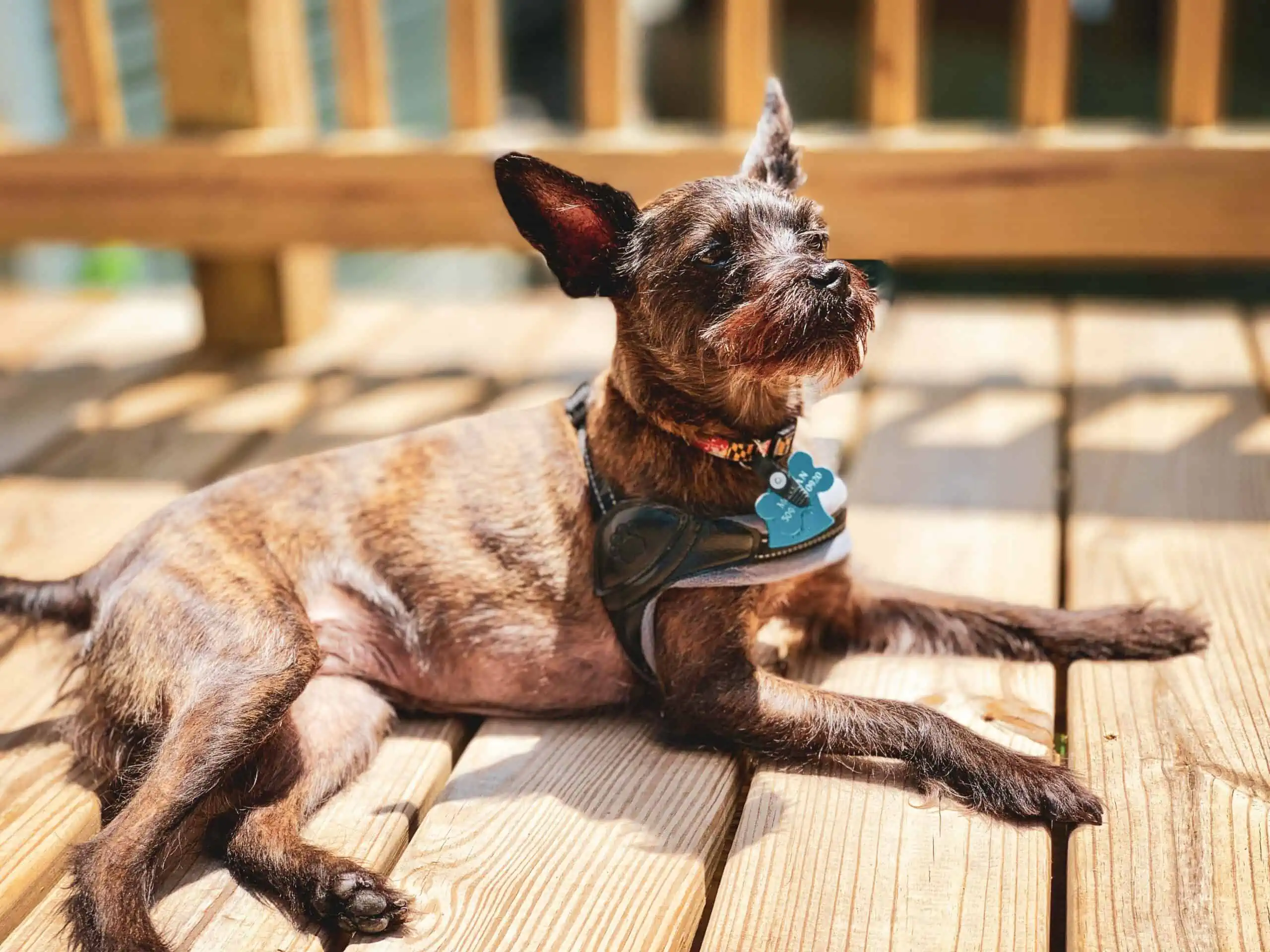When it comes to choosing a pet, there are many factors to consider. Perhaps one of the most important decisions is choosing between a wolfhound and a border terrier.
Both breeds have their own unique set of features that may appeal to different types of pet owners. Here is a closer look at the key differences between these two popular breeds:
Size
One of the most obvious differences between wolfhounds and border terriers is size. Wolfhounds are one of the largest domesticated dog breeds, while border terriers are much smaller in stature.
This can be a major consideration for pet owners who live in small homes or apartments. If space is limited, a border terrier may be the better choice.
Breeding
Another important difference to consider is the purpose for which each breed was originally bred. Wolfhounds were originally bred for hunting large game, such as deer and wild boar. Border terriers, on the other hand, were originally bred for rabbiting and fox hunting.
This difference in history may affect each breed’s temperament and energy level. Wolfhounds are known for being gentle and even-tempered, while border terriers may be more independent and high-spirited.
Appearance
As their names suggest, wolfhounds and border terriers also have different appearances. Wolfhounds are characterized by their large size, wrinkled brows, and long, drooping ears.
Border terriers have a more compact build, with shorter legs and a softer coat of hair. This can be an important consideration for pet owners who prefer a certain type of appearance in their dogs.
Irish Wolfhound
Irish Wolfhounds are one of the largest breeds of dogs, and their appearance is greatly influenced by their size. They have long heads, broad skulls, and powerful jaws. Their eyes are dark and express kind intelligence.
The Irish Wolfhounds’ ears are small and fold over at the tips. Irish Wolfhounds have a long neck, which is muscular and slightly arched. The body is muscular with a deep chest. The legs are strong and straight, with heavy bones.

The feet are large and round, with well-arched toes. The Irish Wolfhound’s tail is thick at the base and tapers to a point. Irish Wolfhounds are born black, brindle, gray, red, fawn, or white; they may also have white markings on the chest, neck, head, or toes.
All colors gradually lighten as the Irish Wolfhound ages; therefore adults Irish Wolfhounds tend to be much lighter in color than puppies. Their larger size sets them apart from most other dogs.
Irish Wolfhounds have a short, coarse outer coat and a dense, downy undercoat. They require minimal grooming; however, they do shed heavily twice a year. IRCA wolfhounds stand 30 to 32 inches tall, weighing 120 to 180 pounds. A Female Irish Wolfhound is usually smaller than a male Irish Wolfhound.
Border Terrier
Border Terriers are a small breed of dog, typically weighing between 11 and 15 pounds. They are good-natured and energetic, with a strong prey drive.

Border Terriers are distinguished by their rough, wiry coat, which is usually brown or black and tan in color. Border Terriers are relatively long-lived for a small breed, with an average lifespan of 12-14 years.
Health Issues In Border Terriers
Health problems that may affect Border Terriers include patellar luxation, epilepsy, and hip dysplasia. Border Terriers are generally healthy dogs, but like all breeds, they can be susceptible to certain health conditions. For this reason, it is important to choose a reputable breeder and to have your Border Terrier checked by a veterinarian regularly.
Temperament
Irish Wolfhounds and Border Terriers are two very different breeds of dogs, but they do share some similarities in their temperaments. Both breeds are intelligent and independent, and they can be willful if they are not given proper training and direction.
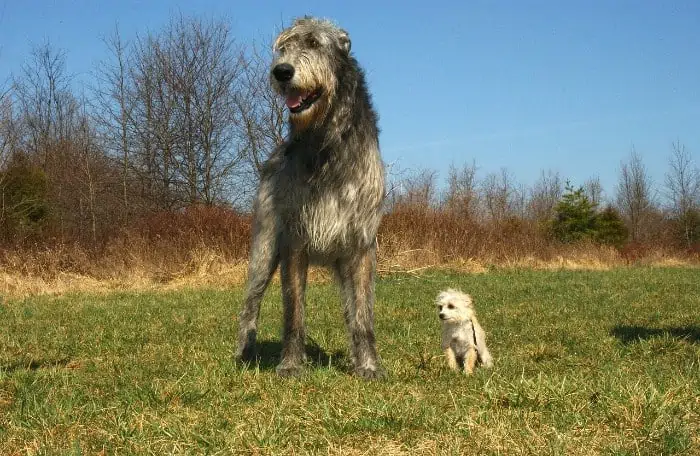
However, the Irish Wolfhound is much larger and more powerful than the Border Terrier, and it is important to socialize this breed early on to prevent aggression (especially against strangers).
The Border Terrier, on the other hand, is a small and delicate breed that is not well suited for families with young children. These dogs are also energetic and playful, and they require a lot of mental stimulation and regular exercise to prevent boredom.
Shedding
Irish Wolfhounds and Border Terriers are both shedding breeds of dogs, but there are some important differences to consider when it comes to their shedding habits.
Irish Wolfhounds are heavy shedders, with a thick coat of fur that needs to be brushed regularly. They also tend to shed more during the spring and fall months.
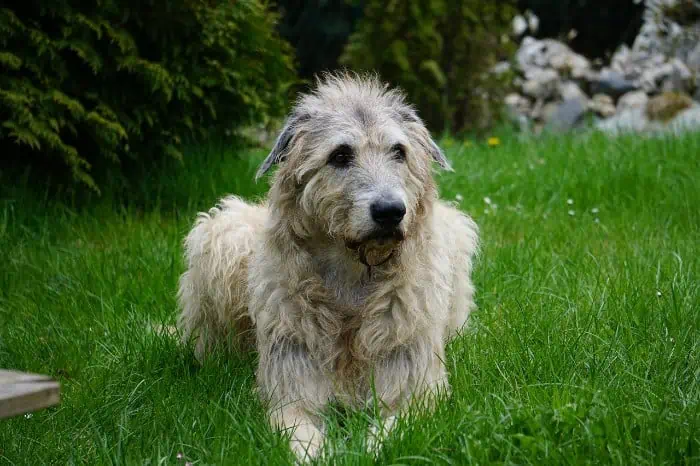
Border Terriers, on the other hand, are light shedders with wiry coat that doesn’t require as much brushing. They typically don’t shed as much as Irish Wolfhounds, but they may shed more during the summer months.
If you’re looking for a breed of dog that doesn’t shed much, Border Terriers are a good option. But if you don’t mind a little extra shedding, Irish Wolfhounds make great companions.
Both Dog Breeds As Family Pets
When it comes to finding the perfect pet for your family, there are many factors to consider. One important question is what size of animal will best fit into your home and lifestyle.
If you’re debating between a small and large breed, Irish wolfhounds and border terriers are two very different yet equally lovable options. Irish wolfhounds are one of the tallest dog breeds, with males averaging 32 inches and females 30 inches. They’re considered a giant breed and weigh an average of 120 pounds.
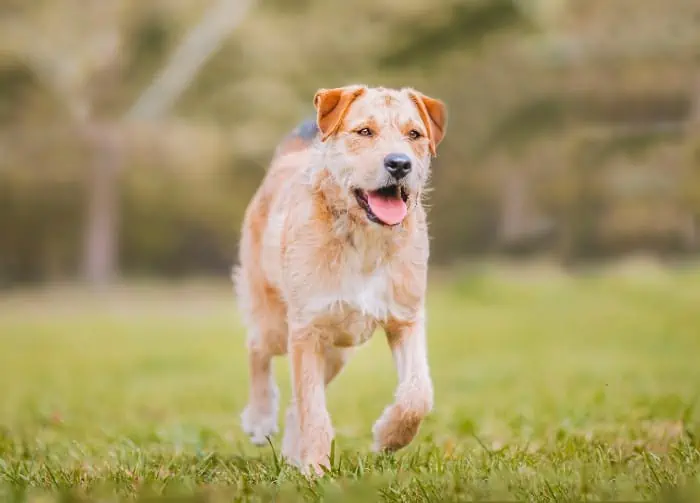
Border terriers, on the other hand, are a small breed that only grows to between 13 and 16 inches tall at the shoulder. They weigh around 11 to 15 pounds. Irish wolfhounds are gentle giants, known for being loyal, loving, and good-natured.
They’re relatively calm dogs and make great companions, but they do need plenty of exercises to stay healthy and happy.
Border terriers are also intelligent and affectionate dogs that make great family pets. They’re active little dogs that love to play, but they don’t require as much exercise as some other small breeds.
When it comes to deciding between an Irish wolfhound or border terrier as a family pet, it’s important to consider your lifestyle and needs. Both breeds make wonderful companions, but their size difference means they’re better suited for different homes and families.
Comparison Overview
When choosing between a wolfhound and a border terrier, there is no right or wrong answer. It ultimately depends on the preferences of the pet owner.
However, taking the time to learn about the key differences between these two breeds can help make the decision process easier.
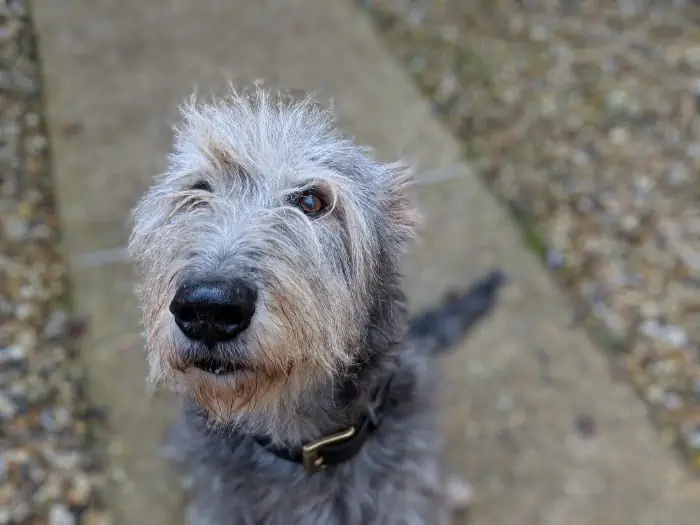
Which Dog Breed May Suit You More?
It depends on what you’re looking for in a pet. If you want an active companion to join you on hikes and walks, then the Border Terrier is probably your best bet.
But if you’re looking for a laid-back personality cuddle buddy who will keep your home safe, then the Irish Wolfhound might be a better choice.
Which breed is prone to separation anxiety: Irish Wolfhound or Border Terrier?
The Irish Wolfhound and the Border Terrier are both breeds that have been known to experience separation anxiety. This type of behavior occurs when a dog is left alone for prolonged periods of time without proper mental stimulation.
The Irish Wolfhound, which is an ancient breed, typically suffers from more intense separation anxiety than the Border Terrier due to its loyalty and intelligence. Although the Border Terrier may also suffer from some form of this disorder, it usually does not show as many signs or exhibit as much distress as the Irish Wolfhound.
It is important to note that any breed of dog can be prone to separation anxiety if it hasn’t been socialized properly or has experienced trauma in its life. Therefore, regardless of whether you own an Irish Wolfhound or a Border Terrier, it is important to provide adequate mental stimulation and companionship for your pet in order to avoid this condition.
Additionally, both breeds should be trained from a young age so as to limit the onset of any separation anxiety-related issues. With patience and consistency, you will be able to create a happy and healthy environment for your beloved pup.
Are Irish Wolfhounds stranger friendly?
Irish Wolfhounds tend to be aloof around strangers and may even display a certain degree of suspicion. This is due to the breed’s historical role, which required them to be protective and vigilant in the presence of unfamiliar people.
Breeding has changed this somewhat, and Irish Wolfhounds today are usually more tolerant towards strangers than they once were. However, it is still important to properly socialize your pet so that it can learn to recognize and accept new people without reacting aggressively or showing signs of anxiety or fear.
With the right training and patience, your Irish Wolfhound should become comfortable with strangers over time. It is also important to remember that no two dogs are exactly alike in terms of temperament or personality, so be sure to take your pet’s individual needs and preferences into account when introducing it to new people.
Is Border Terrier stranger friendly?
Border Terriers are generally friendly and sociable by nature, which makes them usually quite open to strangers. This breed loves attention and is known for its natural curiosity and lively personality.
However, Border Terriers can sometimes experience shyness or apprehension in new or unfamiliar environments. For this reason, it is important to ensure that your pet receives adequate socialization as a pup so that it grows comfortable with people outside of its own family.
With proper training and reinforcement of positive behaviors, you should be able to foster a trusting relationship between your pet and any newcomers it may encounter. Likewise, making sure your dog has plenty of mental stimulation will help keep it from getting anxious when interacting with strangers.
All in all, the Border Terrier is an ideal breed for those looking for a friendly and loyal companion. With the right training and socialization, you will be able to create a safe and secure environment for your pet, as well as appreciate its warm personality and trustworthy nature.
How do Irish Wolfhounds and Border Terriers differ in their barking tendencies?
Irish Wolfhounds and Border Terriers may have different barking tendencies. Both breeds are known to be vocal, but the Irish Wolfhound typically barks more often than the Border Terrier.
The Irish Wolfhound was bred as a guard dog, so it has the instinct to alert its owners of potential danger with loud and persistent barking. The Border Terrier is also capable of barking, but this breed tends to resort to barking only in extreme situations such as when there is an intruder in their home or if they are feeling threatened.
Additionally, the Border Terrier can become easily frustrated if it does not receive enough mental stimulation and will bark as a result of boredom or anxiety. With proper training and socialization, however, both breeds should learn to recognize when it is appropriate to bark and when it is not.
Ultimately, Irish Wolfhounds and Border Terriers both have their own unique barking tendencies, but with the right guidance and understanding, each breed can be taught to bark only when necessary.
What is the life expectancy of an Irish Wolfhound versus a Border Terrier?
The average life expectancy of an Irish Wolfhound is seven to eight years, while the Border Terrier can live up to fifteen years. The shorter lifespan of the Irish Wolfhound is due to its size and predisposition to developing certain health problems.
Conversely, the Border Terrier is a smaller breed and therefore has fewer physical complications as it ages. However, both breeds are susceptible to age-related diseases such as arthritis, so it’s important for owners of each breed to be mindful of their pet’s health needs.
Ultimately, with proper diet and exercise, both breeds can enjoy a longer life span than their average expectations suggest. No matter which breed of dog you choose, it is essential to provide proper nutrition, mental stimulation, and regular veterinary check-ups throughout your life.
By taking the necessary steps to ensure your pet’s health and well-being, you can help them reach their fullest potential and enjoy a long, fulfilling life.
What are the exercise needs of Border Terriers and Irish Wolfhounds comparison?
Border Terriers and Irish Wolfhounds are two of the most popular dog breeds, but they have quite different exercise needs. For Border Terriers, it is important to ensure that they get plenty of physical activity throughout the day.
This might include regular walks, running, and playing with toys in the garden or yard. They may also benefit from more intense activities like agility classes or canine sports.
On the other hand, Irish Wolfhounds need less vigorous exercises than most other large-breed dogs. Long daily walks will keep them healthy and happy, but they can often become stressed or over-exerted if made to participate in strenuous physical activities such as agility classes or long runs.
While both breeds are active and enjoy running around outside, it is important to know the difference between their exercise needs in order to ensure that they are kept healthy and happy.
| Category | Irish Wolfhound | Border Terrier |
|---|---|---|
| Size | Very large (30-35 inches tall and 105-120 pounds) | Small to medium (11-15 inches tall and 11-15 pounds) |
| Coat | The rough, wiry coat | Double coat with a wiry topcoat and soft undercoat |
| Shedding | Moderate shedding | Moderate shedding |
| Temperament | Calm, gentle, and friendly | Intelligent, energetic, and friendly |
| Exercise Needs | Low to moderate exercise needs (short walks and playtime) | Moderate exercise needs (daily walks and playtime) |
| Training | Intelligent and trainable, but can be independent | Intelligent and trainable, but can be stubborn |
| Health Concerns | Prone to genetic health issues such as bloat, hip dysplasia, and heart disease | Prone to genetic health issues such as hip dysplasia, patellar luxation, and allergies |
| Lifespan | 6-8 years | 12-15 years |
| Popularity | Ranked 76th in AKC breed popularity | Ranked 30th in AKC breed popularity |
Conclusion
Ultimately, the Irish Wolfhound and Border Terrier are two distinct breeds with different temperaments, exercise needs, and barking tendencies. While both breeds may have a predisposition for separation anxiety, it is important to socialize your pet properly to avoid this condition.
The Irish Wolfhound tends to be more vocal than the Border Terrier while also requiring significantly more physical activity. On the other hand, French Bulldogs require less exertion but can easily become overweight if their diet isn’t monitored closely or they do not get enough playtime each day.
No matter which breeds you choose as your companion, make sure that you understand its individual needs so that you can provide it with an environment where it feels safe and loved throughout its life.


